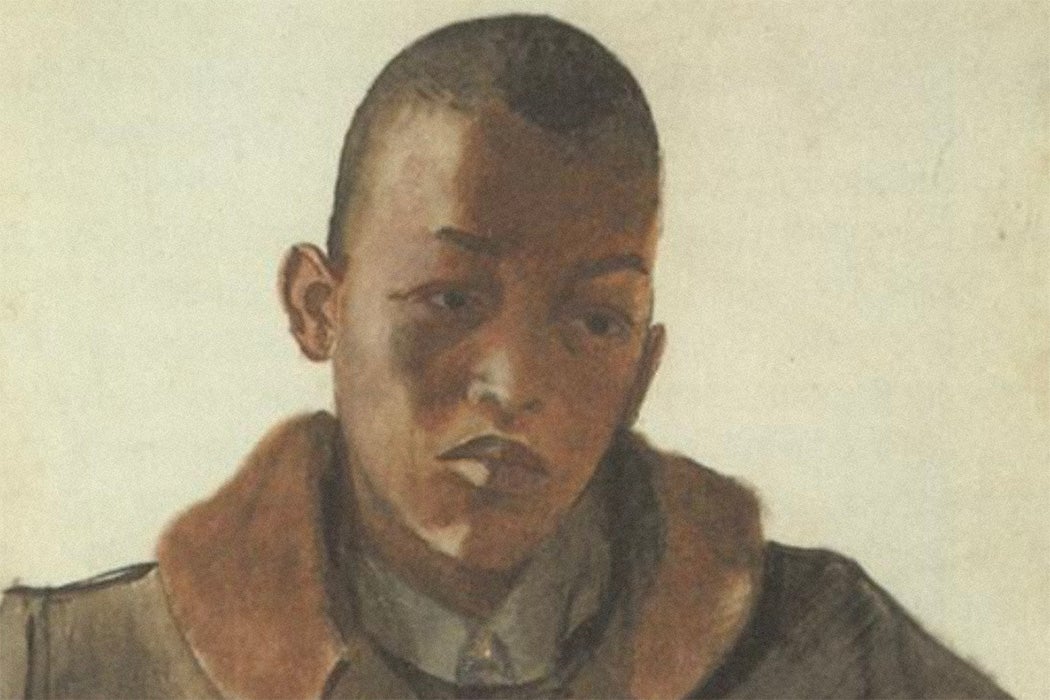Anti-racism was official Communist Party policy in the Soviet Union from 1922. Yet, as art historian Christina Kiaer writes, all the Soviet “noise about anti-racism” didn’t necessarily translate into non-stereotypical images of Black Americans and others of African ancestry by Soviet artists. Few representations “went beyond the stereotyped and symbolic.” Or being props, as in the case of the biracial baby in the 1936 film Tsirk (Circus), in which three-year-old James Lloydovich Patterson plays “a malleable cipher for the fulfillment of Soviet racial enlightenment fantasies.”
The paintings of Alexsandr Deineka were an exception. Deineka (1899–1969) was a preeminent Socialist Realist artist. He survived Stalin, won the Order of Lenin, and was declared People’s Painter of the USSR (1963). His paintings of Black Americans, exhibited in Moscow in 1935, showed unusual nuance.
He didn’t start that way. As Kiaer details it, Deineka began his artistic careering reproducing stereotypes about Blacks as “exotic servants, buffoons, or sidekicks.” In the Soviet 1920s, Blacks were also often portrayed as musicians and entertainers, “intimating the sexuality that was largely absent from Soviet cultural production.”
Then the 1928 Comintern “Resolution on the Negro Question” signaled a big shift: Black individuals were to be portrayed as downtrodden and “oppressed victims of capital.” This new line, which could be quite patronizing, went hand in hand with the notion that Blacks were the vanguard of revolution in the US (with Soviet tutelage).
With these ideological marching orders in hand, Deineka was allowed to tour the US for ten weeks in 1934. He was one of two official Soviet representatives at the “Art of Soviet Russia” exhibit at the Pennsylvania Museum of Art. This was the first Soviet art exhibit in the US, an after-effect of the US diplomatic recognition of the USSR (granted in 1933). The trip was an extraordinary privilege: few Soviet citizens got to see the belly of the capitalist beast so up close and personal.
The work Deineka produced from his American trip was much different from his earlier stereotypical art. It was also pretty different from the usual agitprop. Deineka really made an effort to portray Black Americans as people.
“Against the tide of Soviet images of American racism, Deineka’s pictorial interest was in the self-defined aspects of African-American life that he experienced in Harlem,” writes Kiaer, “or, in other words, on the positive production of African-American social life and culture rather than oppression.”
As it happened, Deineka had met a couple of Black Americans in Moscow even before he traveled. Dorothy West and Mildred Jones were two of the twenty-two Black Americans who came to Moscow in 1932 to take part in a film project called Black and White. Langston Hughes was a script consultant for the project, which sounds like an anti-Klan Birth of A Black Nation. They had arrived amid much hoopla.
But however useful Soviet anti-racism was as a weapon against the US, it was used quite instrumentally. It turned out to be a bad time to make an anti-American film because the Kremlin was wooing the US for diplomatic recognition. Black and White was quickly cancelled, leaving all the would-be actors high and dry. Soviet media coverage of the Scottsboro Boys was also muted at this time.
Weekly Newsletter
Half of the Black and White group left the Soviet Union immediately after the film was cancelled, and others stayed on for varying periods. There was talk of Mildred Jones taking painting lessons from Deineka and Dorothy West modeling for both, but it’s unclear how this turned out.
Lloyd Patterson, another Black and White hopeful, stayed in Moscow permanently and married a Ukrainian woman. It was their baby, James Lloydovich Patterson, who played the biracial baby in Circus. James Patterson’s autobiography of life in the Soviet Union, as child star, poet, and submarine officer, was published in 1964 and translated into English last year when Patterson was 88.
Support JSTOR Daily! Join our membership program on Patreon today.







